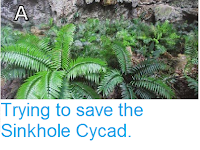The Ventnor Botanic Garden on the Isle of Wight, southern England, has reported that a species of Cycad, the Japanese Sago Palm, Cycas revoluta, (not actually a Palm) has begun 'flowering' on the island, for the first time in Human history. The 'flower' of a Cycad is not a true flower, it is a modified cone, similar to that of a Pine or other Gymnosperm, but is modified for Insect pollination (typically by Beetles), making it large and conspicuous. Cycads are dioeceous, which is to say each plant is either male or female, and typically produce only one large 'flower' each breeding season. They were a dominant Plant group during the Mesozoic, but today are restricted to warmer climates, with the most northerly populations known in Florida and southern Japan. The youngest fossil Cycads from Europe come from the Oligocene Frauenweiler clay pits of Baden-Württemberg in Germany, deposits dated to between 33.9 and 28.4 million years old. They are widely grown in Europe as introduced ornamentals today, but this appears to be the first instance of them flowering outdoors in Northern Europe recorded. The event has been linked to the exceptional heatwave being experienced in Europe at the moment, with many areas having recorded their hottest ever temperatures this summer. Both male and female plants have been flowering at the Ventnor Gardens, and as the area is not home to pollinating Cycad Beetles, and the plants are too far apart to cross-pollinate by other means, staff at the gardens intend to pollinate them artificially.
A male Cycad flower on the Isle of Wight this year. Ventnor Botanic Garden.
Cycad’s are of particular interest to botanists and horticulturalists due to their unique evolutionary heritage; they are Gymnosperms (non-flowering Seed Plants), members of the group that includes Conifers and Ginkos, but among the closest non-flowering relatives of the Angiosperms (Flowering Plants). They large attractive plants, superficially resembling Palms, but producing large and often brightly coloured strobili, structures intermediate between cones and flowers; these are often pollinated by Beetles or Thrips. Cycads are thought to have originated during the Permian, and became dominant Plants in many ecosystems during the Jurassic and Cretaceous, but suffered heavily during the End Cretaceous Extinction, and there are about 330 species surviving today, predominantly in the Southern Hemisphere, most of which diversity is thought to have arisen from a post-Cretaceous radiation.
The approximate distribution of Cycads today. Wikimedia Commons.
There are over 330 known living species of Cycads, the majority of which
are listed on the International Union for the Conservation of Nature’s Red List of Threatened Species, with more than 75% of known species currently thought to
be threatened with extinction. Cycads are threatened by habitat loss and
invasive species (particularly Insects), but are considered to be most at risk
due to over-collecting for horticulture. The distinctive evolutionary history
of the plants, combined with their attractive appearance and drought tolerance,
makes them highly sought after by plant collectors, however they are slow
growing and difficult to raise from seed, resulting in a high market value for
mature plants, which leads to many being taken from the wild. Four species of
Cycad are considered to be extinct in the wild, and it is not thought it will
be possible to reintroduce them to their former environments, as Cycads are
usually co-dependent on single species of pollinators, typically Weevils, with
neither species able to survive in the absence of the other.
See also...
Follow Sciency Thoughts on
Facebook.








